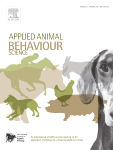Document type: scientific article published in Applied Animal Behaviour Science
Authors: Karen L. Luke, Tina McAdie, Bradley P. Smith, Amanda K. Warren-Smith
Preview: Ridden horse behaviour problems are common and likely contribute to the dangers of horse riding. Emerging evidence suggests ridden horse behaviour problems likely signal poor welfare, however the relationships between ridden horse behaviour, horse welfare and rider safety, are yet to be fully elucidated. This study seeks to address this gap. Modern conceptualisations of animal welfare integrate physical wellbeing and affective state while recognising the dynamic nature of welfare status. Reflecting the latest understanding of animal welfare, the recently updated Five Domains Model emphasises the welfare consequences of husbandry and training practices. However, horse welfare assessment tools generally do not directly measure the ridden aspects of a horse's life. A survey was developed encompassing both husbandry and ridden behavior to incorporate this expanded understanding of horse welfare. Underpinned by the Five Domains Model and existing welfare assessment tools, easily identified aspects of husbandry, health and horse behaviour were selected as animal-based welfare indicators. A relative horse welfare score was calculated based on riders' responses to each indicator. Additionally, riders reported their riding accidents and injuries incidences. Relative horse welfare scores were compared to ridden horse behaviour and rider accidents and injuries. Of the 427 participants, 94.4% were female, mean age was 44.3 years (SD 13.9), 49% were intermediate riders, 81% belonged to an equestrian organisation. The median relative welfare score was 71.0 (IQR 10.0) and 59% of horses performed one or more ridden hyperreactive behaviour in the previous seven days. Relative welfare score and rider accidents and injuries were significantly negatively correlated (r = -0.37, p ≤ 0.001). Rider accidents and injuries were significantly positively correlated with ridden hyperreactive behavior occurrence (r = 0.34, p ≤ 0.001). Limitations included convenience sample and retrospective, self-report methodology. Despite this, the results consistently supported the hypothesis that horses with better welfare perform fewer hyperreactive behaviours and their riders have fewer accidents and injuries. Furthermore, the self-report nature of this study demonstrates it is possible to develop tools for riders that are sensitive enough to detect changes in their horse's welfare that may predict danger in the saddle. Equipping riders with such a tool could raise their awareness of the welfare impacts (positive and negative) of their horse care and training practices. Increased salience of horse welfare coupled with the recognition that horse welfare and human safety are connected, may encourage the adoption of practices that enhance the welfare of horses and likewise, their riders.






